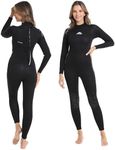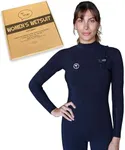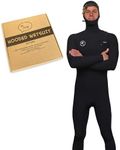Buying Guide for the Best Scuba Diving Wet Suits
Choosing the right scuba diving wetsuit is crucial for ensuring comfort, safety, and an enjoyable diving experience. A wetsuit helps to keep you warm by trapping a thin layer of water between your body and the suit, which is then warmed by your body heat. When selecting a wetsuit, consider the water temperature, your body type, and the type of diving you'll be doing. Here are some key specifications to help you make an informed decision.ThicknessThe thickness of a wetsuit is measured in millimeters and is a key factor in determining how warm the suit will keep you. Thicker wetsuits provide more insulation and are suitable for colder waters, while thinner wetsuits are better for warmer conditions. Typically, wetsuits range from 2mm to 7mm in thickness. For tropical waters (above 75°F/24°C), a 2-3mm suit is sufficient. For temperate waters (60-75°F/16-24°C), a 5mm suit is recommended. For cold waters (below 60°F/16°C), a 7mm suit or thicker is necessary. Choose the thickness based on the water temperature you will be diving in most frequently.
MaterialWetsuits are usually made from neoprene, a synthetic rubber that provides insulation and flexibility. The quality of neoprene can vary, with higher-end suits offering more stretch and comfort. Some wetsuits also feature additional materials like nylon or spandex for added durability and flexibility. If you prioritize comfort and ease of movement, look for wetsuits with high-stretch neoprene. For durability, consider suits with reinforced areas or thicker outer layers.
SeamsThe construction of the seams in a wetsuit affects its warmth and durability. There are several types of seams: flatlock, glued and blind-stitched, and taped. Flatlock seams are strong and flexible but allow some water to seep in, making them suitable for warmer waters. Glued and blind-stitched seams are more watertight and better for colder conditions. Taped seams offer the highest level of waterproofing and durability. Choose the seam type based on the water temperature and how often you dive.
FitA proper fit is essential for a wetsuit to function correctly. The suit should be snug but not too tight, allowing for a full range of motion without causing discomfort. A well-fitting wetsuit will minimize water entry and maximize insulation. When trying on a wetsuit, ensure there are no gaps or loose areas, especially around the neck, wrists, and ankles. Consider your body shape and look for brands that offer a variety of sizes and cuts to find the best fit for you.
StyleWetsuits come in different styles, including full suits, shorties, and two-piece suits. Full suits cover the entire body and are ideal for colder waters. Shorties have short sleeves and legs, making them suitable for warmer conditions. Two-piece suits offer versatility, allowing you to mix and match pieces based on the water temperature. Choose the style that best matches the conditions you will be diving in and your personal preference for coverage and flexibility.
Zipper TypeThe type of zipper on a wetsuit can affect its ease of use and water resistance. Back zippers are the most common and easiest to put on and take off, but they may allow some water to enter. Chest zippers provide a better seal and are more watertight but can be harder to get into. There are also zipperless wetsuits that offer maximum flexibility and water resistance but can be challenging to put on. Consider how important ease of use and water resistance are to you when choosing a zipper type.





















